TUCSON, Ariz. (KGUN) — Toggling a model of a microchip, fourth year student at the University of Arizona Jaeden Carpenter looked at the design of a microchip on his computer.
When he was finished, he put on virtual reality and augmented reality goggles that allowed him to look at the microchip he was learning about in class.
“In an augmented reality environment, the students will be able to see what each layer means,” Carpenter said.
He also used the model of the microchip on the computer to 3D print parts of a plastic microchip model. It wasn’t an actual microchip, but it allowed him to learn about the parts of one.
“There are microchips that are used for computing and then there are microchips that are used to create those microchips,” he explained.
Microchips can be used in all kinds of electronics from computers to phones.
Carpenter is hoping to become an electrical and computer engineer when he graduates, and is hoping to also get a PhD in the same field.
About a week ago, President Joe Biden announced that the federal government would be giving money and loans to Intel through the CHIPS Act.
This will allow Intel to modernize one of their existing facilities and build two new ones in Chandler, Arizona.
Carpenter feels like their expansion could help students like him.
“So Intel will help us with our work development by just creating a better environment and giving more funds to be able to create these projects that we’re working on. We’re trying to make them as minimal price as possible,” he said.
Christina Dinh, a master science engineering student said making actual microchips in class is helping students gain the knowledge they need to get jobs with Intel or other microchip manufacturing companies.
“Usually in class you would just be thinking about the theory, but not understanding what it’s physically like, so once you’re in the cleanroom, you could be like oh, this is what this machine does,” Dinh said.
By 2030, the Biden Administration said the U.S. is going to be making about 20 percent of our world’s chips.
After the recent chip shortage, professor Dr. Soheil Salehi said that’s going to help the economy.
“We want to have a more robust supply chain of microelectronics and the economy can benefit significantly from that,” Salehi said.
The University said they are in the process of partnering with the Chandler Unified School District and several colleges such as Pima Community College to design courses that will help students get credits at at the U of A.
It’s all in hopes that students choose microchip-related jobs, which the University said could help companies like Intel.
In the meantime, students like Carpenter are already thinking of ideas so they can get students as young as five years old interested in microchip manufacturing.
“If you have that foundation before college, you’re going to be ahead,” Carpenter said.
——-
Andrew Christiansen is a reporter for KGUN 9. Before joining the team, Andrew reported in Corpus Christi, Texas for KRIS6 News, Action 10 News and guest reported in Spanish for Telemundo Corpus Christi. Share your story ideas with Andrew by emailing andrew.christiansen@kgun9.com or by connecting on Facebook, or Twitter.







